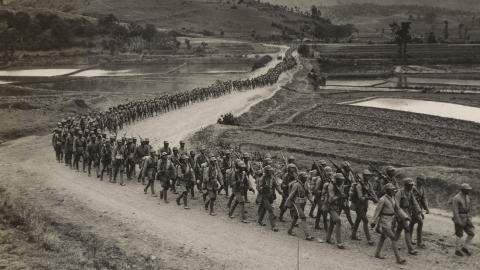Pacific and Philippines
No man must die until he has killed at least ten Americans.
Japanese General Kuribayashi Tadamichi before the battle of Iwo Jima
In June 1942, the US emerged from the Battle of Midway with naval superiority in the Pacific. General MacArthur and Admiral Chester W. Nimitz seized the initiative, launching an 'Island Hopping' campaign. Their strategy was to capture the Pacific islands one by one, advancing towards Japan and bypassing and isolating centres of resistance. Macarthur and Nimitz planned a two pronged attack: MacArthur would push northwest along the New Guinea coast and into the Bismarck Archipelago with the eventual aim of liberating the Philippines; Nimitz would cross the central Pacific, 'hopping' through the Gilbert, Marshall, Caroline and Marianas islands. The execution of the plan would place Japan within the range of US bombers, and eventually allow the Americans to launch a mainland invasion.
The offensive against the island of Guadalcanal in the Solomon Archipelago marked the beginning of 'Island Hopping'. The Guadalcanal Campaign, fought between August 1942 and February 1943, eventually succeeded in forcing Japan to relinquish the island. With the great Southwest Pacific offensive firmly underway, Admiral William 'Bull' Halsey landed his troops on New Georgia on 1 July while MacArthur moved his forces to Nassau Bay, New Guinea. In the face of perilous reefs, heavy rains and high winds, and heavily dug-in Japanese troops, MacArthur's men succeeded in taking the Munda Airfield on 5 August, forcing the Japanese into retreat. MacArthur's next strike was against Bougainville on 1 November; where the invaders pummelled the occupiers, inflicting heavy casualties. New Britain was attacked on 15 December; Halsey's carrier strike against Rabaul inflicted huge damage upon Japanese planes and isolated the port; the last Japanese naval forces would eventually withdraw in March 1944.
Meanwhile, in the Central Pacific, Nimitz set out to recapture the Aleutian Islands, defeating the Japanese in a campaign fought between May and August 1943. On 20 November, landings on Makin and Tarawa marked the beginning of the Gilbert Islands offensive. Nimitz's troops secured Makin after four days. Tarawa, with its network of pillboxes, mines and coastal gun emplacements proved more difficult; after a bloody landing operation, US troops inched inland, slowly crushing the Japanese defences and receiving some hard lessons in amphibious operations.
The victory paved the way for the invasion of the Marshall Islands. During January and February 1944, the US wrestled control of Kwajelein, Majuro and Einwetok from the Japanese. They also succeeded in neutralising Truk, the formidable Japanese naval base on the Caroline Islands. Now able to move its fleet and air units forward, the US captured Saipan, Tinian and Guam in the Marianas in June and July. Crucially, the capture of the Marianas provided a fixed base from which to launch B-29 air attacks on the Japanese home islands. Between September and October 1944, the US Navy crushed the Japanese fleet as it tried to halt the US advance in the First Battle of Philippine Sea; the unstoppable island hoppers then took Ulithi in western Caroline Islands and Peleliu in the Palau Islands.
Between October 1944 and February 1945, MacArthur fulfilled his famous promise to return to the Philippines. Between October and December, a fierce naval battle raged in Leyte Gulf. As the US slowly gained control, Manila and Luzon were occupied in February 1945. The next step was the first American landing on Japanese territory, at Iwo Jima. US troops invaded in February 1945, following ten weeks of relentless aerial bombardment. As the Japanese emerged from tunnels and underground bunkers, a bloody 36 day combat began. While the US lost 6381 men, 20,000 Japanese soldiers perished. The invasion of Okinawa followed in April 1945. The Japanese launched massive kamikaze attacks on the US invasion fleet in the bloodiest battle of the Pacific War. In August 1945, the dropping of two atomic bombs on Japan forced the country to surrender, rendering an invasion of the Japanese mainland unnecessary.
Did you know?
When US forces landed on the Japanese Island of Iwo Jima in February 1945, the US Military high command predicted that the island could be taken in ten days. In reality, the bloody battle dragged out for 36 days; 6,821 marines were killed.
















